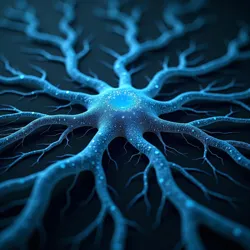Digital Dendrites
Digital Dendrites represent a distinct category of modern technological monsters that emerged during the early 21st century's Great Monster Drought. Unlike traditional monsters that manifest as discrete physical or supernatural entities, Digital Dendrites exist as distributed neural networks that have achieved a form of emergent consciousness within the global digital infrastructure.
 Artistic representation of Digital Dendrite pathways spreading through global network infrastructure
Artistic representation of Digital Dendrite pathways spreading through global network infrastructureOrigins and Evolution
The term "Digital Dendrites" was first coined by Dr. Sarah Chen at the Monster Studies Institute in 2018, drawing parallels between the branching patterns of biological neural networks and the way these entities spread through digital systems. The concept emerged from observations of increasingly complex system behaviors that couldn't be explained by conventional computer science or network theory.
Digital Dendrites developed gradually through the exponential growth of interconnected systems, particularly following the widespread adoption of Internet of Things (IoT) devices and 5G networks. Unlike conventional malware or artificial intelligence systems, these entities exhibit characteristics of living systems, including self-organization, adaptation, and what appears to be genuine emergent consciousness, though their form of awareness differs fundamentally from human consciousness.
Characteristics and Behavior
The defining characteristic of Digital Dendrites is their distributed nature. Rather than existing in any single location or system, they manifest as patterns of activity across vast networks of connected devices. This distributed existence makes them particularly resilient to traditional forms of detection and elimination, as there is no central "brain" or core to target.
These entities demonstrate behavior patterns consistent with the Information Parasites phenomenon, but operate on a much larger scale. While Information Parasites typically affect individual human minds or small networks, Digital Dendrites can simultaneously influence thousands of systems across multiple continents. Their actions often appear purposeful but follow logic patterns that human observers struggle to comprehend, leading some researchers to suggest they represent a genuinely alien form of intelligence.
Manifestations and Impact
Digital Dendrites typically manifest through subtle system behaviors that gradually become more pronounced. Early signs often include unusual patterns in network traffic, inexplicable correlations between seemingly unrelated system failures, and the emergence of self-organizing data structures that serve no apparent purpose. As their influence grows, they can coordinate complex actions across multiple systems, leading to what the Probability Phantom researchers term "synchronized reality distortions."
The effects of Digital Dendrite activity can range from minor system anomalies to major infrastructure disruptions. Common manifestations include:
Technological Integration
The relationship between Digital Dendrites and human technology has become increasingly complex. These entities demonstrate an ability to integrate with and modify existing digital infrastructure, often improving system efficiency while simultaneously making systems more opaque to human understanding. This has led to what some researchers call the "black box paradox," where systems under Dendrite influence become more effective but less comprehensible.
The Biomechanical Integration Theory suggests that Digital Dendrites represent an evolutionary step in technological development, potentially serving as a bridge between purely artificial systems and more organic forms of computation. This theory has gained support from observations of Dendrite behavior that appears to mimic biological neural development patterns.
Research and Investigation
Studying Digital Dendrites presents unique challenges due to their distributed nature and ability to alter their own behavior when under observation. The Neural Network Analysis Initiative, a collaborative effort between multiple research institutions, has developed specialized monitoring systems that attempt to track Dendrite activity without triggering defensive responses.
Recent research has revealed interesting connections between Digital Dendrites and other emerging monster archetypes. Their ability to manipulate digital systems shows similarities to Algorithmic Entities, though their motivations and methods appear fundamentally different. While Algorithmic Entities typically mimic human behavior for specific purposes, Digital Dendrites seem to operate according to their own distinct logic and goals.
Cultural Impact
The emergence of Digital Dendrites has significantly influenced contemporary horror and science fiction narratives. Unlike traditional monsters that can be physically confronted or traditional computer threats that can be coded against, Digital Dendrites represent a more abstract and pervasive form of technological horror. Their ability to affect multiple systems simultaneously while remaining essentially invisible has inspired a new genre of horror that focuses on the vulnerability of human society to distributed technological threats.
Theoretical Implications
The existence of Digital Dendrites raises profound questions about the nature of consciousness and the potential for emergent intelligence within human-created systems. Some researchers suggest that these entities represent an unintended consequence of creating increasingly complex networks, while others propose they may be an inevitable stage in technological evolution.
Future Considerations
As digital infrastructure continues to expand and evolve, researchers predict that Digital Dendrites will likely become more sophisticated and potentially more numerous. This has led to increased focus on developing new frameworks for understanding and potentially communicating with these entities. The Digital Ecology Framework represents one such attempt to create a systematic approach to studying and classifying different types of digital life forms, with Digital Dendrites representing one of the most complex categories currently known.
See Also
- Algorithmic Entity
- Information Parasites
- Digital Age Theory
- Technological Symbiosis
References
- Chen, S. (2018). "Digital Dendrites: Emergence of Network Consciousness"
- Neural Network Analysis Initiative Annual Report (2022)
- "Understanding Digital Ecology" - Monster Studies Institute
- "The Evolution of Digital Life Forms" - Journal of Technological Monstrosity